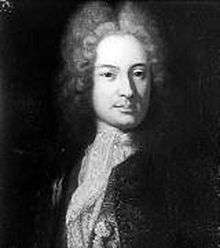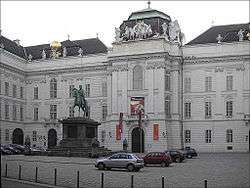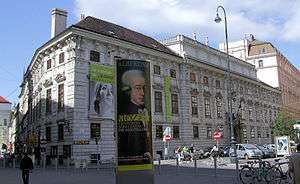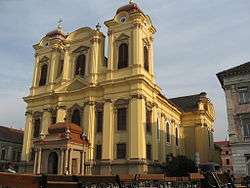Joseph Emanuel Fischer von Erlach
Joseph Emanuel Fischer von Erlach, also Fischer von Erlach the younger (13 September 1693 in Vienna – 29 June 1742 in Vienna) was an Austrian architect of the Baroque, Rococo and Baroque classicism.[1]
Joseph Emanuel Fischer von Erlach | |
|---|---|
 | |
| Born | 13 September 1693 |
| Died | 29 June 1742 (aged 48) Vienna |
| Occupation | Architect |
| Buildings | |
Biography
He was the son of Johann Bernhard Fischer von Erlach. He continued some projects of his father, in particular, the Karlskirche, the Hofbibliothek (Imperial Library), and the Winterreitschultrakt (Winter Riding School) of the Hofburg. However, after his father, he also worked on many palaces, castles, and churches, as well as numerous monuments, gardens, tombs, and altars (see "Works" below).[1]
He first developed his skills in his father's workshop. In 1711, he worked on several of his father's commissions (e.g. Palais Dietrichstein, Trautson Palace, Böhmi Hofkanzlei, Schwarzenberg Palace) and also helped complete the publication "Draft of a historical architecture"; whose four volumes inspired many later designs. Through this work, Joseph Emanuel came into contact both with the architecture of his and earlier times and with Berne, his father's noble order.
His father also involved Joseph Emanuel in the writing of "Folders and Outlines of some buildings of Vienna, self-drawn from J.E.F.v.E.," with a preface by the court antiquarian Carl Gustav Heraeus. This publication was resumed later by Salomon Kleiner.
Until 1714, he received instruction in Vienna from his father's guest Gottfried Leibniz. The two obtained a travel scholarship for Joseph Emanuel from Kaiser Karl VI. This led him in 1713/1714 to Italy, where he accompanied, among others, the well-known archaeologist Francesco de Ficoroni.
From 1717 to 1719, he was in France with the French court master-builder Robert de Cotte, the architect Germain Boffrand, and with the philologist Bernard de Montfaucon. He also spent time in Leyden and London, where he studied the re-invented Steam engines and possibly also met Isaac Newton.
In 1722 he returned to Vienna. He sought and obtained (in December 1722) a court architect position where he also exercised his considerable technical abilities, building the first steam engine in continental Europe (at Schwarzenberg Palace) during the same year. After the death of his father 1723, Johann Lucas von Hildebrandt succeeded to the position of chief Court Architect. In 1725, Joseph Emanuel, succeeded in turn to this position, probably with the help of his powerful sponsor, Court Building director, count Gundaker von Althan, completing his father's unfinished projects. Though a successful architect in his own right, he was overshadowed by his more famous father.
In 1727, he had married Maria Anna von Dietrich, with whom he had 7 children. He lived in the Gerstenbrandische Haus (Gerstenbrandi house) with the Kärntner gate. He had an important art collection and extensive library. His wife died in 1740.
In 1729, Joseph Emanuel was appointed Imperial Court Chamber Advisor and dedicated himself increasingly to building steam engines for mine excavation. For this work he was made a Baron in 1735.
He continued some projects of his father, in particular the Karlskirche, the Hofbibliothek (Imperial Library), and the Winterreitschultrakt of the Hofburg. He was involved with the planning of the Traktes of the Hofburg for Michaelerplatz, which only in the years of Ferdinand Kirschner (with easy changes) was built only much later (1889–1893) and with some modifications, since the Hofburg theatre stood in the way. On the same plans, he based also Königliche library in Berlin, which from 1775 to 1780 was built by George Christian Unger. In 1728, he replaced Johann Lucas von Hildebrandt with the building the Reichskanzleitraktes of the Hofburg. Otherwise, few own works are secured – in addition, this has to do with unclear documents. Added to this are 1847 the Althan palace in Vienna on Landstrasse, Corps de logis Eckartsau Castle, and Thürnthal Castle at Fels am Wagram.
Joseph Emanuel Fischer von Erlach died on 29 June 1742 in a house fire. He left an enormous fortune of 130,000 fl.
Impact
Contrary to his father's approach, the son thought in terms of facades, which are however different from those of Hildebrandt and his numerous successors and a perfect example of Western Europeanbaroque classicism: simple, rational and without effusive ornamentation.
Works



- Monumental Buildings:
- Plans to the Michaelertrakt in the Hofburg, 1726
- Execution of Kaiserlichen Court Library (Hofbibliothek) in Vienna
- Winter riding school
- Reichskanzleitrakt of the Hofburg (Court Castle continuation after Hildebrandt)
- Completion of Hofstallungen Court stable buildings (today: Museum accommodation), 1725
- Transformation of the Stift Klosterneuburg (Klosterneuburg Monastery)
- Castles and Palaces:
- Schloss Eckartsau (Eckartsau Castle)
- Change of Schloss Thürnthal, 1725 (deutsch-link)
- Change of Schloss Kirchstetten (deutsch-link)
- Change of Schloss Joslowitz (Jaroslavice, Tschechien) (deutsch-link)
- Change of Austerlitz Palace (Slavkov u Brna, Tschechien)
- Change of Schloss Seelowitz (Tschechien) (deutsch-link)
- Change of Schloss Frain (Vranov nad Dyjí, Tschechien) (deutsch-link)
- Althan Palace (garden palace)
- Completion Schwarzenberg Palace (baroque garden palace), 1728
- Change of Lamberg Palace, 1730
- Change of Lobkowitz Palace (deutsch-link)
- Planning of the Ritterakademie palace (knight academy) in Liegnitz
- Planning of the Bánffy Castle castle in Bonţida
- Sacred Buildings:
- Continuation of Karlskirche
- Parish church in Grossweikersdorf
- Reestablishment of the church and the yard of the parsonage in Šafov (Tschechien), 1745
- Other:
- Building Vermählungsbrunnen of Hoher Markt (high market) after plans of his father
- Ehrentempel Honour temples on Wiener Graben
- numerous monuments, gardens, tombs and altars.
Notes
- As of November 14, 2006, most of the information was a direct translation from the corresponding German Wikipedia article: De-WP-JEFischer.